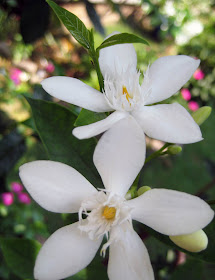This is a liana which I have trimmed to a shrub form. The flowers of this vine are bell-shaped (campanulate) with the petals splayed out flat from the tubular section.

Ten deep pink fingerlike projections extend from the flower center.

The pastel pink flowers have a mild pleasant fragrance.
After a few days, the pink hue fades while the finger-like projections turn burgundy or maroon. The pink throat turn to burgundy too.
Overtime, the flowers assume a light cream pallor, while the ten projections appear to be cafe au lait in colour.
Though the flower has passed its prime, but it still look majestically glorious with a crown-like structure in the centre.

The flowers are presented in a type of inflorescence called an umbel.

The flower petals just before unfurling appear thick and succulent.

The leaves are glossy and
smooth and drip a watery milky sap if broken.

It is said that the its seeds are highly toxic and thus used extensively in the preparation of arrow poison by certain tribes.



The ten pink fingerlike projections that extend from the flower center is emulated in the design of my 'Mad Hatter' teapot.
































